2008 Hyundai Azera warning
[x] Cancel search: warningPage 47 of 345
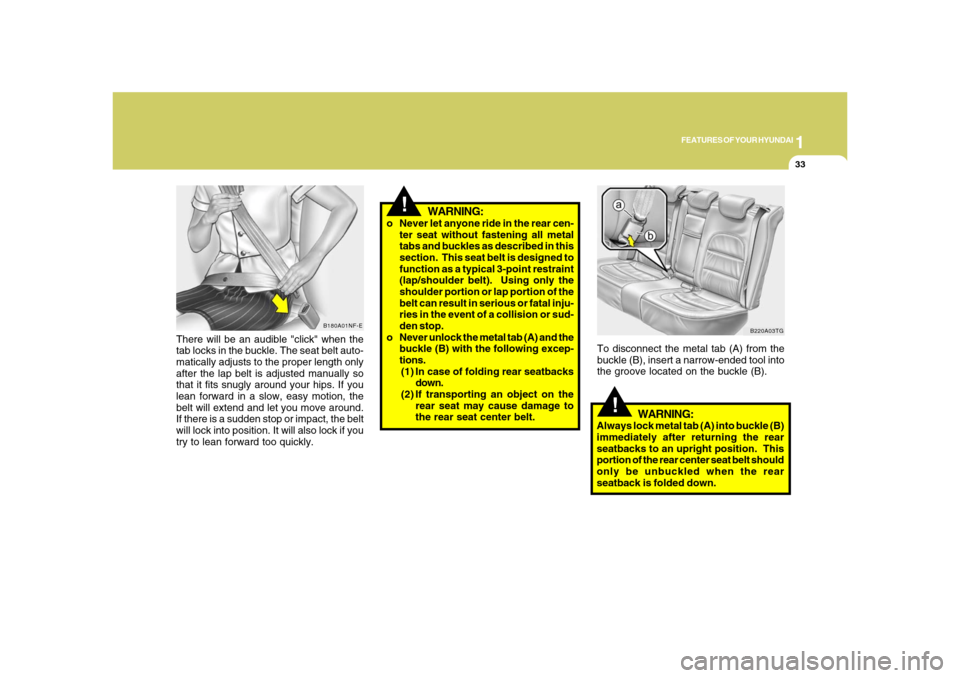
1
FEATURES OF YOUR HYUNDAI
33
There will be an audible "click" when the
tab locks in the buckle. The seat belt auto-
matically adjusts to the proper length only
after the lap belt is adjusted manually so
that it fits snugly around your hips. If you
lean forward in a slow, easy motion, the
belt will extend and let you move around.
If there is a sudden stop or impact, the belt
will lock into position. It will also lock if you
try to lean forward too quickly.
!
WARNING:
o Never let anyone ride in the rear cen-
ter seat without fastening all metal
tabs and buckles as described in this
section. This seat belt is designed to
function as a typical 3-point restraint
(lap/shoulder belt). Using only the
shoulder portion or lap portion of the
belt can result in serious or fatal inju-
ries in the event of a collision or sud-
den stop.
o Never unlock the metal tab (A) and the
buckle (B) with the following excep-
tions.
(1) In case of folding rear seatbacks
down.
(2) If transporting an object on the
rear seat may cause damage to
the rear seat center belt.
B180A01NF-E
!
B220A03TG
To disconnect the metal tab (A) from the
buckle (B), insert a narrow-ended tool into
the groove located on the buckle (B).
WARNING:
Always lock metal tab (A) into buckle (B)
immediately after returning the rear
seatbacks to an upright position. This
portion of the rear center seat belt should
only be unbuckled when the rear
seatback is folded down.
Page 48 of 345
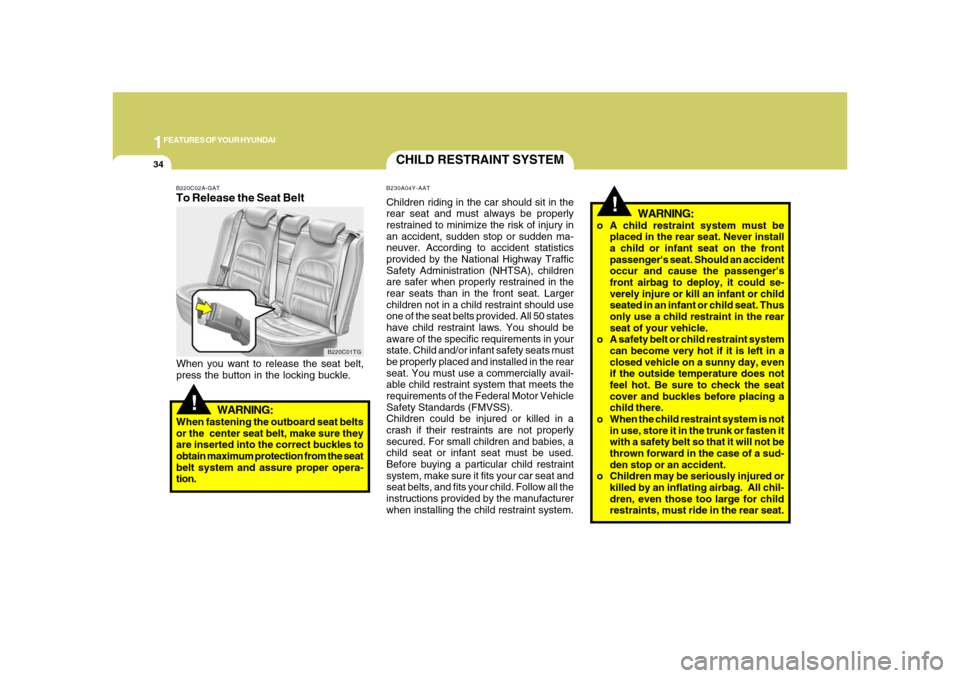
1FEATURES OF YOUR HYUNDAI34
!
WARNING:
o A child restraint system must be
placed in the rear seat. Never install
a child or infant seat on the front
passenger's seat. Should an accident
occur and cause the passenger's
front airbag to deploy, it could se-
verely injure or kill an infant or child
seated in an infant or child seat. Thus
only use a child restraint in the rear
seat of your vehicle.
o A safety belt or child restraint system
can become very hot if it is left in a
closed vehicle on a sunny day, even
if the outside temperature does not
feel hot. Be sure to check the seat
cover and buckles before placing a
child there.
o When the child restraint system is not
in use, store it in the trunk or fasten it
with a safety belt so that it will not be
thrown forward in the case of a sud-
den stop or an accident.
o Children may be seriously injured or
killed by an inflating airbag. All chil-
dren, even those too large for child
restraints, must ride in the rear seat.
B220C02A-GATTo Release the Seat BeltWhen you want to release the seat belt,
press the button in the locking buckle.
!
WARNING:
When fastening the outboard seat belts
or the center seat belt, make sure they
are inserted into the correct buckles to
obtain maximum protection from the seat
belt system and assure proper opera-
tion.
CHILD RESTRAINT SYSTEMB230A04Y-AATChildren riding in the car should sit in the
rear seat and must always be properly
restrained to minimize the risk of injury in
an accident, sudden stop or sudden ma-
neuver. According to accident statistics
provided by the National Highway Traffic
Safety Administration (NHTSA), children
are safer when properly restrained in the
rear seats than in the front seat. Larger
children not in a child restraint should use
one of the seat belts provided. All 50 states
have child restraint laws. You should be
aware of the specific requirements in your
state. Child and/or infant safety seats must
be properly placed and installed in the rear
seat. You must use a commercially avail-
able child restraint system that meets the
requirements of the Federal Motor Vehicle
Safety Standards (FMVSS).
Children could be injured or killed in a
crash if their restraints are not properly
secured. For small children and babies, a
child seat or infant seat must be used.
Before buying a particular child restraint
system, make sure it fits your car seat and
seat belts, and fits your child. Follow all the
instructions provided by the manufacturer
when installing the child restraint system.
B220C01TG
Page 49 of 345
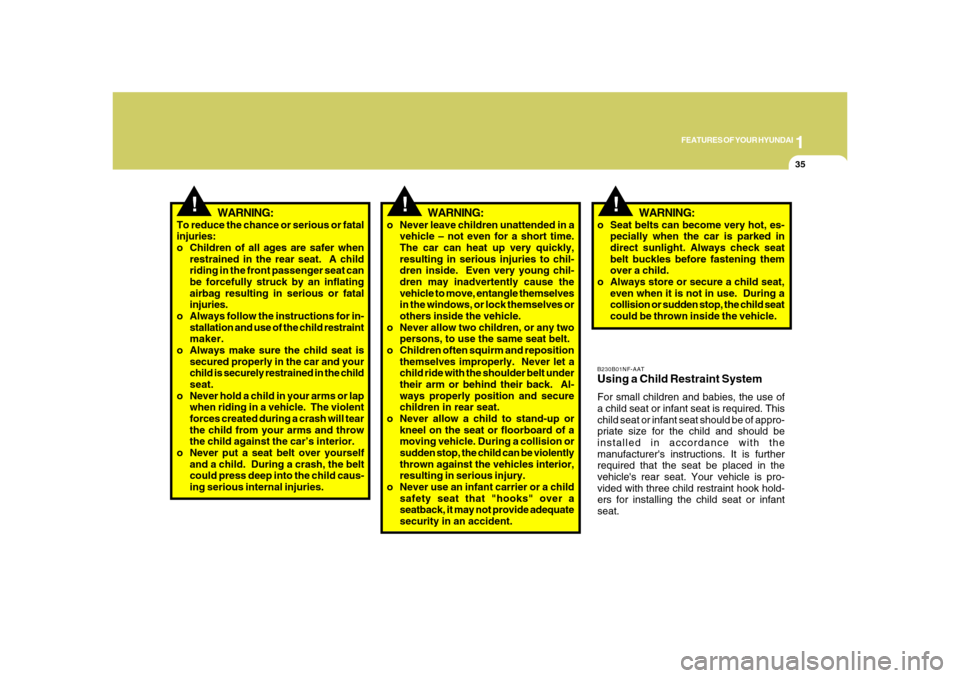
1
FEATURES OF YOUR HYUNDAI
35
!
To reduce the chance or serious or fatal
injuries:
o Children of all ages are safer when
restrained in the rear seat. A child
riding in the front passenger seat can
be forcefully struck by an inflating
airbag resulting in serious or fatal
injuries.
o Always follow the instructions for in-
stallation and use of the child restraint
maker.
o Always make sure the child seat is
secured properly in the car and your
child is securely restrained in the child
seat.
o Never hold a child in your arms or lap
when riding in a vehicle. The violent
forces created during a crash will tear
the child from your arms and throw
the child against the car’s interior.
o Never put a seat belt over yourself
and a child. During a crash, the belt
could press deep into the child caus-
ing serious internal injuries.o Never leave children unattended in a
vehicle – not even for a short time.
The car can heat up very quickly,
resulting in serious injuries to chil-
dren inside. Even very young chil-
dren may inadvertently cause the
vehicle to move, entangle themselves
in the windows, or lock themselves or
others inside the vehicle.
o Never allow two children, or any two
persons, to use the same seat belt.
o Children often squirm and reposition
themselves improperly. Never let a
child ride with the shoulder belt under
their arm or behind their back. Al-
ways properly position and secure
children in rear seat.
o Never allow a child to stand-up or
kneel on the seat or floorboard of a
moving vehicle. During a collision or
sudden stop, the child can be violently
thrown against the vehicles interior,
resulting in serious injury.
o Never use an infant carrier or a child
safety seat that "hooks" over a
seatback, it may not provide adequate
security in an accident.
!
WARNING: WARNING:
!
WARNING:
B230B01NF-AATUsing a Child Restraint SystemFor small children and babies, the use of
a child seat or infant seat is required. This
child seat or infant seat should be of appro-
priate size for the child and should be
installed in accordance with the
manufacturer's instructions. It is further
required that the seat be placed in the
vehicle's rear seat. Your vehicle is pro-
vided with three child restraint hook hold-
ers for installing the child seat or infant
seat. o Seat belts can become very hot, es-
pecially when the car is parked in
direct sunlight. Always check seat
belt buckles before fastening them
over a child.
o Always store or secure a child seat,
even when it is not in use. During a
collision or sudden stop, the child seat
could be thrown inside the vehicle.
Page 50 of 345

1FEATURES OF YOUR HYUNDAI36
!For vehicles with adjustable headrests,
route the tether strap under the head-
rest and between the headrest posts,
otherwise route the tether strap over the
top of the seatback.
3. Connect the tether strap hook to the
child restraint hook holder and tighten
to secure the seat.
WARNING:
o A child can be seriously injured or
killed in a collision if the child restraint
is not properly anchored. Always
follow the child seat manufacturer’s
instructions for installation and use.
o Never mount more than one child re-
straint to a single tether or to a single
lower anchorage point. The increased
load caused by multiple seats may
cause the tethers or anchorage points
to break, causing serious injury or
death.
2. Route the child restraint seat tether strap
over the seatback.
B230C02TG
Rear seat package trayTether Strap Hook
Child Restraint Hook Holders
B230C05A-AATInstalling a Child Restraint Seat with
the "Tether Anchorage" SystemThree child restraint hook holders are lo-
cated on the rear seat package tray.To install the child restraint seat1. Open the tether anchor cover on the
rear seat package tray.
B230C01TG
Tether Anchor Cover
Child Restraint
Hook Holder
Front of Vehicle
Page 51 of 345
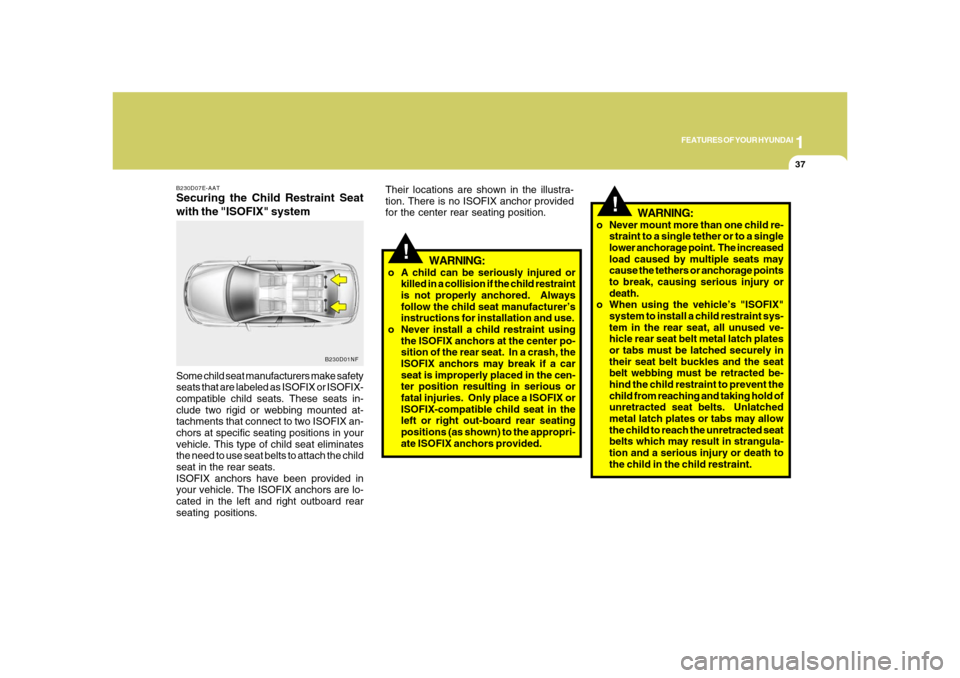
1
FEATURES OF YOUR HYUNDAI
37
B230D07E-AATSecuring the Child Restraint Seat
with the "ISOFIX" systemSome child seat manufacturers make safety
seats that are labeled as ISOFIX or ISOFIX-
compatible child seats. These seats in-
clude two rigid or webbing mounted at-
tachments that connect to two ISOFIX an-
chors at specific seating positions in your
vehicle. This type of child seat eliminates
the need to use seat belts to attach the child
seat in the rear seats.
ISOFIX anchors have been provided in
your vehicle. The ISOFIX anchors are lo-
cated in the left and right outboard rear
seating positions.
B230D01NF
!
WARNING:
o A child can be seriously injured or
killed in a collision if the child restraint
is not properly anchored. Always
follow the child seat manufacturer’s
instructions for installation and use.
o Never install a child restraint using
the ISOFIX anchors at the center po-
sition of the rear seat. In a crash, the
ISOFIX anchors may break if a car
seat is improperly placed in the cen-
ter position resulting in serious or
fatal injuries. Only place a ISOFIX or
ISOFIX-compatible child seat in the
left or right out-board rear seating
positions (as shown) to the appropri-
ate ISOFIX anchors provided. Their locations are shown in the illustra-
tion. There is no ISOFIX anchor provided
for the center rear seating position.
!
o Never mount more than one child re-
straint to a single tether or to a single
lower anchorage point. The increased
load caused by multiple seats may
cause the tethers or anchorage points
to break, causing serious injury or
death.
o When using the vehicle’s "ISOFIX"
system to install a child restraint sys-
tem in the rear seat, all unused ve-
hicle rear seat belt metal latch plates
or tabs must be latched securely in
their seat belt buckles and the seat
belt webbing must be retracted be-
hind the child restraint to prevent the
child from reaching and taking hold of
unretracted seat belts. Unlatched
metal latch plates or tabs may allow
the child to reach the unretracted seat
belts which may result in strangula-
tion and a serious injury or death to
the child in the child restraint.
WARNING:
Page 52 of 345
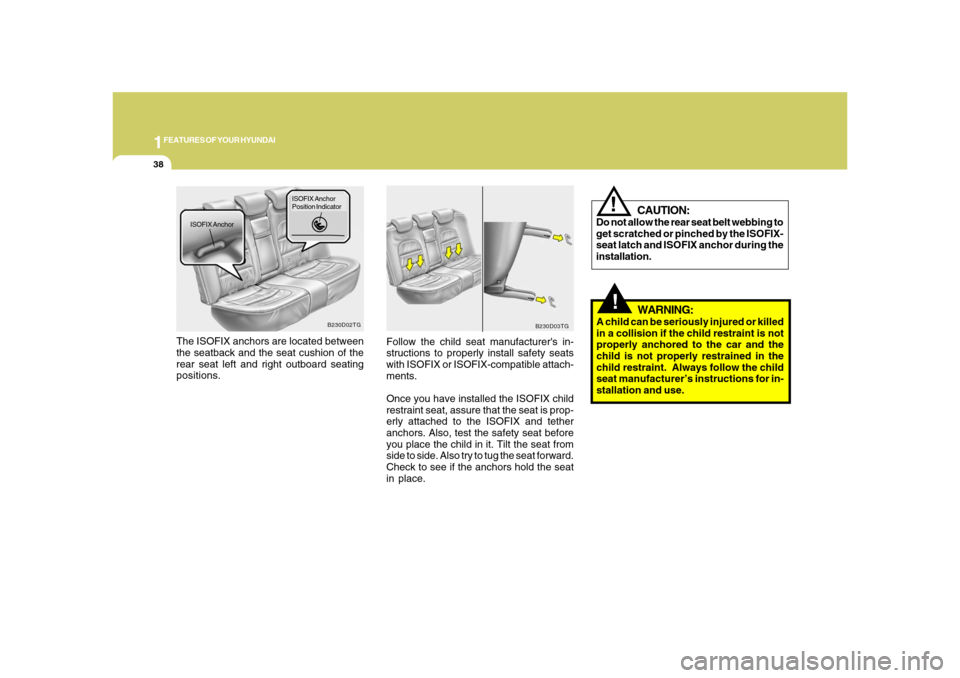
1FEATURES OF YOUR HYUNDAI38
!
WARNING:
A child can be seriously injured or killed
in a collision if the child restraint is not
properly anchored to the car and the
child is not properly restrained in the
child restraint. Always follow the child
seat manufacturer’s instructions for in-
stallation and use.
The ISOFIX anchors are located between
the seatback and the seat cushion of the
rear seat left and right outboard seating
positions.
B230D02TG
ISOFIX AnchorISOFIX Anchor
Position Indicator
B230D03TG
Follow the child seat manufacturer's in-
structions to properly install safety seats
with ISOFIX or ISOFIX-compatible attach-
ments.
Once you have installed the ISOFIX child
restraint seat, assure that the seat is prop-
erly attached to the ISOFIX and tether
anchors. Also, test the safety seat before
you place the child in it. Tilt the seat from
side to side. Also try to tug the seat forward.
Check to see if the anchors hold the seat
in place.
!
CAUTION:
Do not allow the rear seat belt webbing to
get scratched or pinched by the ISOFIX-
seat latch and ISOFIX anchor during the
installation.
Page 54 of 345
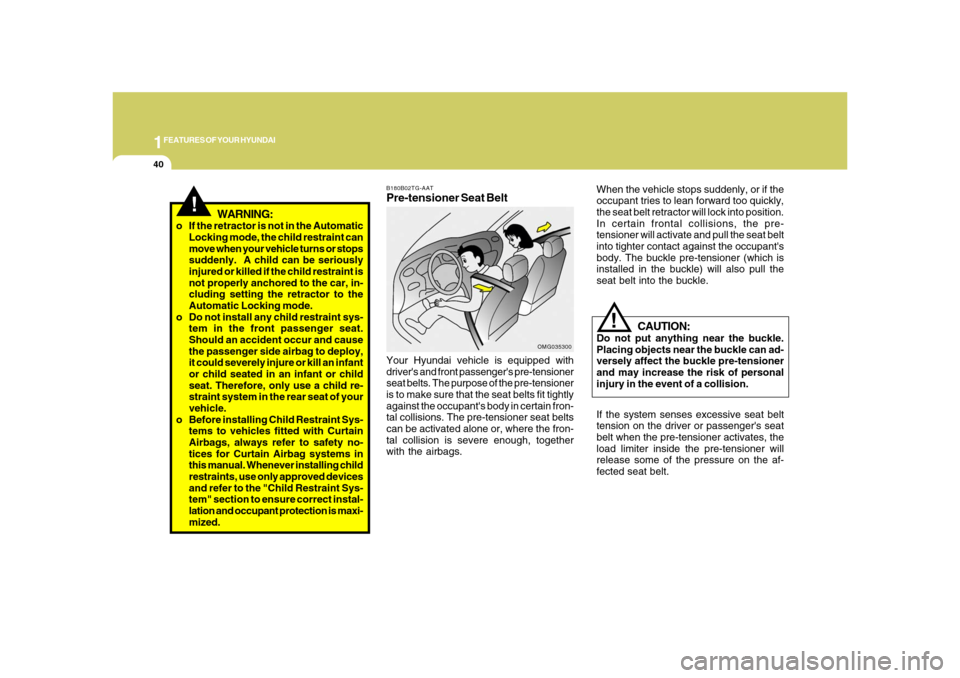
1FEATURES OF YOUR HYUNDAI40
!
CAUTION:
Do not put anything near the buckle.
Placing objects near the buckle can ad-
versely affect the buckle pre-tensioner
and may increase the risk of personal
injury in the event of a collision.
If the system senses excessive seat belt
tension on the driver or passenger's seat
belt when the pre-tensioner activates, the
load limiter inside the pre-tensioner will
release some of the pressure on the af-
fected seat belt. When the vehicle stops suddenly, or if the
occupant tries to lean forward too quickly,
the seat belt retractor will lock into position.
In certain frontal collisions, the pre-
tensioner will activate and pull the seat belt
into tighter contact against the occupant's
body. The buckle pre-tensioner (which is
installed in the buckle) will also pull the
seat belt into the buckle.
!
WARNING:
o If the retractor is not in the Automatic
Locking mode, the child restraint can
move when your vehicle turns or stops
suddenly. A child can be seriously
injured or killed if the child restraint is
not properly anchored to the car, in-
cluding setting the retractor to the
Automatic Locking mode.
o Do not install any child restraint sys-
tem in the front passenger seat.
Should an accident occur and cause
the passenger side airbag to deploy,
it could severely injure or kill an infant
or child seated in an infant or child
seat. Therefore, only use a child re-
straint system in the rear seat of your
vehicle.
o Before installing Child Restraint Sys-
tems to vehicles fitted with Curtain
Airbags, always refer to safety no-
tices for Curtain Airbag systems in
this manual. Whenever installing child
restraints, use only approved devices
and refer to the "Child Restraint Sys-
tem" section to ensure correct instal-
lation and occupant protection is maxi-
mized.
B180B02TG-AATPre-tensioner Seat BeltYour Hyundai vehicle is equipped with
driver's and front passenger's pre-tensioner
seat belts. The purpose of the pre-tensioner
is to make sure that the seat belts fit tightly
against the occupant's body in certain fron-
tal collisions. The pre-tensioner seat belts
can be activated alone or, where the fron-
tal collision is severe enough, together
with the airbags.
OMG035300
Page 55 of 345
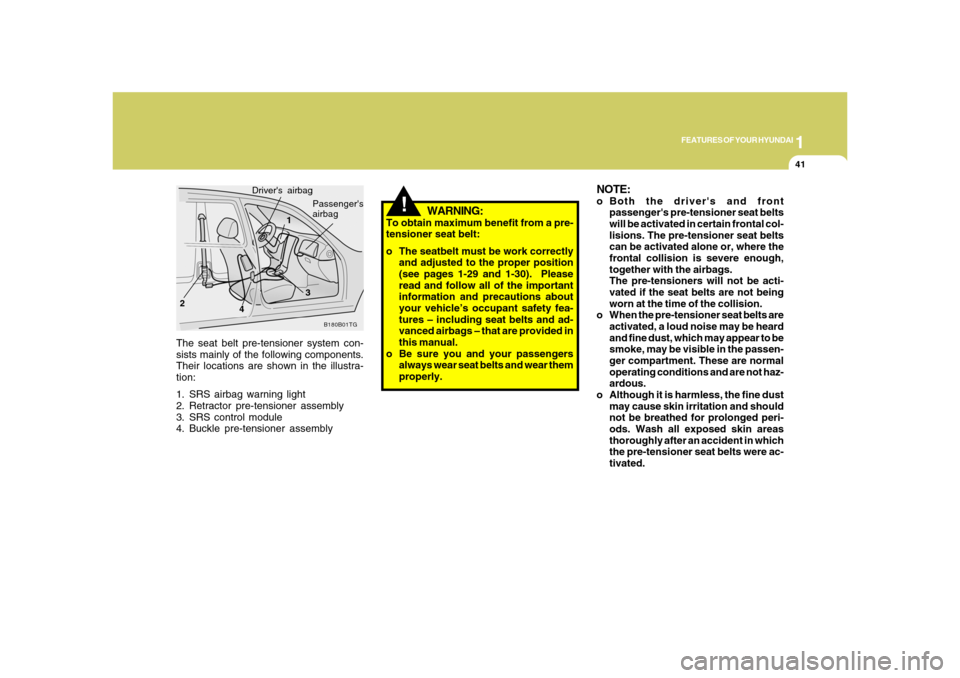
1
FEATURES OF YOUR HYUNDAI
41
!
The seat belt pre-tensioner system con-
sists mainly of the following components.
Their locations are shown in the illustra-
tion:
1. SRS airbag warning light
2. Retractor pre-tensioner assembly
3. SRS control module
4. Buckle pre-tensioner assembly
B180B01TG
1
23 Driver's airbag
Passenger's
airbag
WARNING:
To obtain maximum benefit from a pre-
tensioner seat belt:
o The seatbelt must be work correctly
and adjusted to the proper position
(see pages 1-29 and 1-30). Please
read and follow all of the important
information and precautions about
your vehicle’s occupant safety fea-
tures – including seat belts and ad-
vanced airbags – that are provided in
this manual.
o Be sure you and your passengers
always wear seat belts and wear them
properly.
4
NOTE:o Both the driver's and front
passenger's pre-tensioner seat belts
will be activated in certain frontal col-
lisions. The pre-tensioner seat belts
can be activated alone or, where the
frontal collision is severe enough,
together with the airbags.
The pre-tensioners will not be acti-
vated if the seat belts are not being
worn at the time of the collision.
o When the pre-tensioner seat belts are
activated, a loud noise may be heard
and fine dust, which may appear to be
smoke, may be visible in the passen-
ger compartment. These are normal
operating conditions and are not haz-
ardous.
o Although it is harmless, the fine dust
may cause skin irritation and should
not be breathed for prolonged peri-
ods. Wash all exposed skin areas
thoroughly after an accident in which
the pre-tensioner seat belts were ac-
tivated.